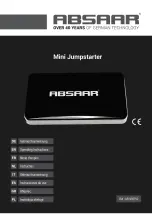ADT7476A
www.onsemi.com
19
and null it out using the offset registers. The offset registers
automatically add a twos complement 8-bit reading to every
temperature measurement.
Changing Bit 1 of Configuration Register 5 (0x7C)
changes the resolution and therefore, the range of the
temperature offset as either having a −63
°
C to +127
°
C range
with a resolution of 1
°
C or having a −63
°
C to +64
°
C range
with a resolution of 0.5
°
C. This temperature offset can be
used to compensate for linear temperature errors introduced
by noise.
Table 16. TEMPERATURE OFFSET REGISTERS
Register
Description
Default
0x70
Remote 1 Temperature Offset
0x00 (0
°
C)
0x71
Local Temperature Offset
0x00 (0
°
C)
0x72
Remote 2 Temperature Offset
0x00 (0
°
C)
ADT7463/ADT7476A Backwards Compatible Mode
By setting Bit 0 of Configuration Register 5 (0x7C), all
temperature measurements are stored in the zone
temperature reading registers (0x25, 0x26, and 0x27) in
twos complement in the −63
°
C to +127
°
C range. The
temperature limits must be reprogrammed in twos
complement.
If a twos complement temperature below −63
°
C is
entered, the temperature is clamped to −63
°
C. In this mode,
the diode fault condition remains −128
°
C = 1000 0000,
while in the extended temperature range (−63
°
C to +191
°
C),
the fault condition is represented by −64
°
C = 0000 0000.
Table 17. TEMPERATURE READING REGISTERS
Register
Description
Default
0x25
Remote 1 Temperature
−
0x26
Local Temperature
−
0x27
Remote 2 Temperature
−
0x77
Extended Resolution 2
0x00
Table 18. EXTENDED RESOLUTION TEMPERATURE
MEASUREMENT REGISTER BITS
Bit
Mnemonic
Description
[7:6]
TDM2
Remote 2 Temperature LSBs
[5:4]
LTMP
Local Temperature LSBs
[3:2]
TDM1
Remote 1 Temperature LSBs
Temperature Limit Registers
Associated with each temperature measurement channel
are high and low limit registers. Exceeding the programmed
high or low limit causes the appropriate status bit to be set.
Exceeding either limit can also generate SMBALERT
interrupts (depending on the way the interrupt mask register
is programmed and assuming that SMBALERT is set as an
output on the appropriate pin).
Table 19. TEMPERATURE LIMIT REGISTERS
Register
Description
Default
0x4E
Remote 1 Temperature Low Limit
0x81
0x4F
Remote 1 Temperature High Limit
0x7F
0x50
Local Temperature Low Limit
0x81
0x51
Local Temperature High Limit
0x7F
0x52
Remote 2 Temperature Low Limit
0x81
0x53
Remote 2 Temperature High Limit
0x7F
Reading Temperature from the ADT7476A
It is important to note that temperature can be read from
the ADT7476A as an 8-bit value (with 1
°
C resolution) or as
a 10-bit value (with 0.25
°
C resolution). If only 1
°
C
resolution is required, the temperature readings can be read
back at any time and in no particular order.
If the 10-bit measurement is required, this involves a
2-register read for each measurement. Extended Resolution
Register 2 (0x77) should be read first. This causes all
temperature reading registers to be frozen until all
temperature reading registers have been read from. This
prevents an MSB reading from being updated while its two
LSBs are being read and vice versa.
Additional ADC Functions for Temperature
Measurement
A number of other functions are available on the
ADT7476A to offer the system designer increased
flexibility.
Turn-off Averaging
For each temperature measurement read from a value
register, 16 readings have actually been made internally, and
the results averaged, before being placed into the value
register. Sometimes it is necessary to take a very fast
measurement. Setting Bit 4 of Configuration Register 2
(0x73) turns averaging off. The default round robin cycle
time takes 146.5 ms.
Table 20. CONVERSION TIME WITH AVERAGING
DISABLED
Channel
Measurement Time (ms)
Voltage Channels
0.7
Remote Temperature 1
7
Remote Temperature 2
7
Local Temperature
1.3
When Bit 7 of Configuration Register 6 (0x10) is set, the
default round robin cycle time increases to 240 ms.
Table 21. CONVERSION TIME WITH AVERAGING
ENABLED
Channel
Measurement Time (ms)
Voltage Channels
11
Remote Temperature
39
Local Temperature
12
Downloaded from
Downloaded from
Downloaded from
Downloaded from
Downloaded from
Downloaded from
Downloaded from
Downloaded from
Downloaded from
Downloaded from
Downloaded from
Downloaded from
Downloaded from
Downloaded from
Downloaded from
Downloaded from
Downloaded from
Downloaded from
Downloaded from


















